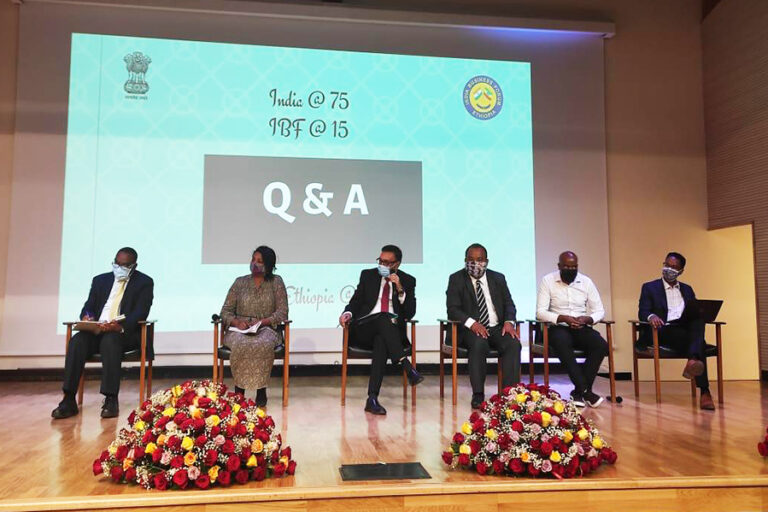Ethiopian Shipping and Logistics Services Enterprise (ESLSE) says the effect of global box shortage is scrambling its operation from time to time. Container freight rates price spikes by triple.
Recently, Capital reported that in relation with the global pandemic, COVID 19, economic slowdown had engulfed the logistics sector. Moreover, containers being stranded in different destination globally fueled to the fire as it created shortage for operators including ESLSE. Amid this event, Roba Megersa, CEO of ESLSE, told Capital this week that the effect has become severe from time to time.
He said that the activity of ESLSE, which had registered marvelous performance on container handling in the recent past, has significantly slowdown. “We used to be delivering containerized cargos effectively but clients and our operations are now affected by the shortage.”
The international business that mainly derives from maritime sector is becoming critical in related with mismatch on demand and supply. International reports indicated that there is no sign of easing of freight rates as demand exceeds available slots and containers.
The export from China and Far East has increased by all actors including the western world thus the heavy congestion has occurred on Chinese ports.
“Ports and shipping operators are using it as a lucrative advantage to impose huge amount of additional sum on the logistics operation,” Roba complained.
The rate of shipping for containerized cargo has tripled, “such kind of increment has never been seen in the industry.”
Ports have also increased the port service fee on the reason for additional costs for the deployment system and resource, and over time fee for labour to mobilize the congestion. But the increment rate is not like shipping.
International experts on the maritime business said that terminals cannot run at full capacity, yet they have to deal with record volumes.
“Currently, the export of US and others in the region has dropped significantly due to that access to container has directly affected the industry including mainly our business,” the CEO said.
The containerized export of US and Latin America is on its 40 percent from the actual performance due to this effect those containers that entered in the stated region have stuck.
The global average usage time for containers had risen from 49 days to 58 days in related with the impact on container availability.
“The trade imbalance on the economic giants, China that is now on manufacturing port export boom and the US, has directly created an entire mess on the sector,” he showed the entire linkage effect on his enterprise operation.
According to Roba, carriers that have contract with ESLSE under its tender for six months are now unable to lift cargos because of the extraordinary price.
“The latest rate is not profitable for shippers due to that they are running for their own businesses,” he said. Carriers that ESLSE has hired under every six month tender scheme manage 80 percent of its cargos, while the remainder is covered by ESLSE’s vessels.
“Carriers like PIL, who were unable to penetrate the Ethiopian market because of their untrustworthiness, have now got the opportunity to enter the market. These carriers are lifting cargos on exaggerated price of up to USD 10,000 per forty feet container and over USD 5,000 for TUE that ESLSE is charging one third of the stated rates.
“These kind of shippers are sabotaging us in different tactics like refusing to provides slots and move cargos that we gave waivers,” he explained.
He argued that ESLSE is giving waivers for the sake of keeping the logistics sector to be active, “ we cannot stop the waivers because the letter of credit (LC) of clients shall be expired if cargos delays. On the other hand if customers want to extend their LC they have to pay huge sums in foreign currency. Due to that we give waivers.”
Experts said the waiver consignment rate that is managed by carriers like unreliable ones is much exaggerated and costs the country and clients.
Under the waiver scheme clients receive their cargos at Djibouti, while ESLSE on its multimodal operation provides value added service like delivering the cargos at its dry port or customer’s warehouse.
“Because of the situation our performance has cupped on 60 percent. We had targeted to manage 18,000 containers per month that is now stuck on 11, 000,” the CEO shows the effects in figures.
Unlike the previous trend the containership calls at Djibouti, which registered biggest recognition on container handling by the World Bank latest report, has declined by 20 percent due to the stated global situation. He said that container handling at the port is about 40 percent from its capacity.
Experts said customers including projects, which were on good execution in Addis Ababa and elsewhere in the country that ESLSE gave waivers, are delayed because of working with untrustworthy carriers.
Lloyd’s List latest report indicated that there is little chance of congestion in the supply chain being resolved before the fourth quarter of the year.
Container shortage overburdens ESLSE
Cooperation between Ethiopia, India based on mutual respect, benefit
The cooperation between Ethiopia and India is a good example of South-South cooperation based on mutual respect and benefit, Foreign Affairs State Minister Tsion Teklu said.
Speaking at a discussion forum organized by Embassy of India and India Business Forum on Tuesday May 25, the state minister said the relationship between the two countries has deepened significantly and their cooperation is based on mutual respect and benefit.
This is a good example of South-South cooperation and Ethiopia draws meaningful lessons from India’s experiences and expertise in different areas, she added.
Noting that India is among the largest sources of FID in Ethiopia, Tsion said, adding that “what makes India unique is the fact that the contribution is not only through investment but also trade, education, consultancy and capacity building.” According to her, the Government of Ethiopia is working tirelessly to widen and deepen its reforms which promote democratization, rule of law, god governance as well as working on the serious measures aimed at reforming the economy and financial management so as to promote transparency and accountability across the entire administration.
According to her, the Government of Ethiopia is working tirelessly to widen and deepen its reforms which promote democratization, rule of law, god governance as well as working on the serious measures aimed at reforming the economy and financial management so as to promote transparency and accountability across the entire administration.
This will make Ethiopia one of the best destinations of FDI in Africa, the state minister pointed out.
India’s Ambassador to Ethiopia, Shetkintong Robert said Indian companies are among the largest foreign investors in Ethiopia engaged in different sectors.
“During the last one year alone we have 35 new Indian investment projects here in Ethiopia, despite the COVID-19 pandemic,” Ambassador Robert stated.
There are about 607 Indian companies in Ethiopia with licensed investment of over 5 billion USD, out of which about 3 billion USD is estimated to be on the ground and created jobs for 75,000 people.
About 60 percent of Indian investments are in manufacturing, followed by 18 percent in agriculture. Others are in floriculture, engineering, plastics, cotton and textiles, water management, consultancy and ICT, education, pharmaceuticals and health care.
Ethio telecom aggressively upgrading its service
Ethio telecom is aggressively upgrading its service all over the country making it the most vibrant company in the country. Despite the process of privatization the sole telecom provider is advancing its service in different parts of the country.
This time the company yet again launched its 4G LTE Advanced service in its East Region on Tuesday May 25 and Central East Region on Thursday May 27. East 0Region includes Dire Dawa, Ayisha and Chiro towns while the Central East Region includes Harar, Aweday and Haremaya towns.
The expansion is based on where the company said that there is high mobile data traffic and surge in demand. “The service covers areas with a high demand for speedy internet,” said Frehiwot Tamiru, CEO of Ethio telecom during the launching ceremony.
LTE Advanced mobile service is one of the latest mobile technologies providing reliable connections enriching customers’ experience with exceptional speed to download or upload large-sized data, high-definition (HD) multimedia, live streaming and video conferencing in real-time.

The new expansion will enable and empower customers to digitize their services, increase productivity and improve their experiences.
Speaking about the expansion of the new project at the launching ceremony Frehiwot said, “It opens a new chapter and brings an immediate impact on congested areas of telecom service.”
Our massive 4G LTE expansion in the country including the one we made here today is also aimed at facilitating conditions for the mobile banking service including the newly-launched Telebirr. The internet service advancement in the area also contributes to modernizing economic activities and easing COVID-19’s business impact thereby helping the country’s move to digital economy, she remarked.
The project is one of ethio telecom’s three-year growth strategies, including data traffic growth, and demand-based 4G/LTE expansion around the country.
Ethio telecom’s internet penetration rate has also surpassed the overall sub-Saharan countries’ operators. The current mobile penetration in Ethiopia is over 51 percent while it is 45 percent in sub-Sahara Africa.
The reliability and high-speed features of the 4G LTE service will also increase productivity and improve experiences of the over 1.3 million ethio telecom customers in the region of which 330,000 have smart phones capable of operating the advanced service. The CEO further stated that amongst the 244 ethio telecom stations in the East Region, 47 will run the advanced service which is 11 times faster than the existing connectivity.
further stated that amongst the 244 ethio telecom stations in the East Region, 47 will run the advanced service which is 11 times faster than the existing connectivity.
Prior to this launch, ethio telecom has established a 4G network in its South East, North-West, East East, South South West regions within 2021, following the 4G launch in capital Addis Ababa one year earlier. The operator has also a vision to launch 5G by 2022 at pilot level.
Nyala Insurance S.C purchases a 26 mln birr bond for GERD construction
Nyala Insurance S.C has purchased a 26.7 Million Birr Bond in support of the construction of the Grand Ethiopian Renaissance Dam.
Officials and public figures who attended the ceremony have extended gratitude to the company on behalf of Ethiopians for its support of the national flag project.
It is stated on the occasion that the National Public Participation Coordination Office has mobilized more than 17 Billion Birr for the construction of GERD from the community.
The construction of the dam has reached close to 80 percent according to officials.






